U12 Soccer Drills: 7 Fantastic Drills for 12-Year-Olds
Two things:
1. Development
2. Fun
These should be your main focus when selecting U12 soccer drills to use with your team.
At the 12-and-under age group, it's crucial that we're putting players in a position to improve their skills in a friendly and fun environment.
Below, I've put together 5x U12 soccer drills.
All of these drills include purpose, setup, instructions, variations, coaching points, and more...
Let's get started.
7 U12 Soccer Drills
1. 4v3 Attack
How the Drill Works:
Four players attempt to score on three defenders and a goalkeeper defending one goal.
Purpose:
Develop passing, decision-making and finishing abilities. Players improve their ability to pass the ball around defenders and switch the point of attack to create scoring opportunities.
Setup:
- Set up a 30x30-yard field with one full-size goal on an end line.
- One team of three will start as the defensive team, 15 yards in front of goal. The other team of and one team of four will start as the attacking team on the end line opposite of the goal. Assign jersey colors to each team. See diagram for more information.
- Position one goalkeeper in goal.
- Gather all the soccer balls behind the end line opposite of the goal.
- One player on the attacking team starts with the ball.
- Play three, four-minute games. Add more time and rounds as needed. Rotate players between games.
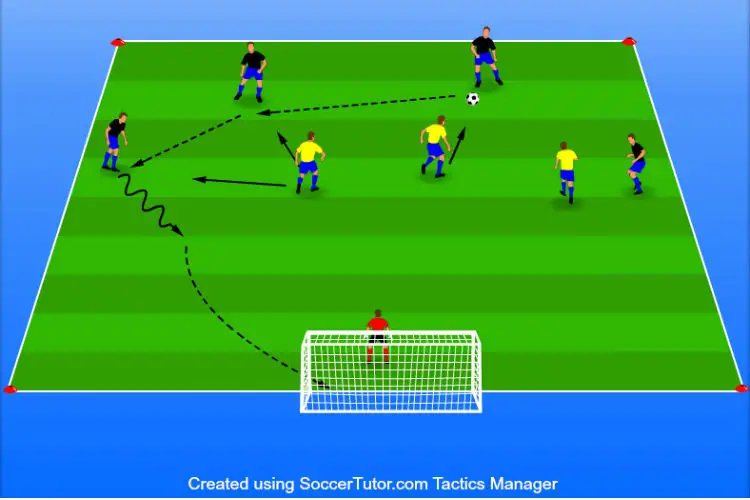
Instructions:
- The attacking team attempts to pass the ball side-to-side, around the defenders and create a scoring opportunity.
- The three defenders attempt to shift with the ball and stay compact until there is a moment to win the ball or block a shot.
- If the defenders win the ball, they attempt to keep possession as long as they can inside the box using their goalkeeper.
- If the ball goes out-of-bounds for any reason, players reset to their starting positions and a new ball is started with the attacking team.
- Play offsides to keep the game realistic.
- Play three, four-minute games. Add more time and rounds as needed. Rotate players between games. See which attacking group can score the most goals!
Variations:
Number of players – Play 5v4, 5v3, 6v4, etc. Adjust the field size as needed. Set up players in game formations and positions as more players are added.
Coaching Points:
- Teach the attackers to dribble forward to commit defenders and then pass the ball wide to the open player.
- Remind the attackers to switch the point of attack quickly before the defenders can shift over.
- Instruct the players to make quick decisions and be creative on the ball.
- Encourage the players to look up and have an idea before they receive the ball.
- Challenge the defenders to cover the ground and close down space! Defenders should stay compact and make the attackers play around them.
2. 5v4 Prevent Forward Play
How the Drill Works:
One team of four attempts to prevent the team of five from dribbling or passing into the end zone. The team of four works on defending in a flat line and winning the ball to counter in one of the three mini-goals.
Purpose:
Develop a team’s ability to prevent forward play in a flat four line. Players improve their defensive movement, positioning and balance as they try to win the ball and counter.
Setup:
- Set up one 24x44-yard field for every nine players.
- Set up three mini-goals on one end line of each field. Use cones, or poles, to mark gates if mini-goals are unavailable.
- Mark a five-yard end zone box on the opposite end line of the mini-goals on each field.
- On each field, divide the players into one team of four and one team of five.
- The team of four will defend the end zone and position themselves as a flat line.
- The team of five will be the attackers attempting to dribble or pass the ball into the end zone.
- The soccer balls start near the mini-goals.
- Play four-minute games before resting and rotating players. Play for a total of 30 minutes.
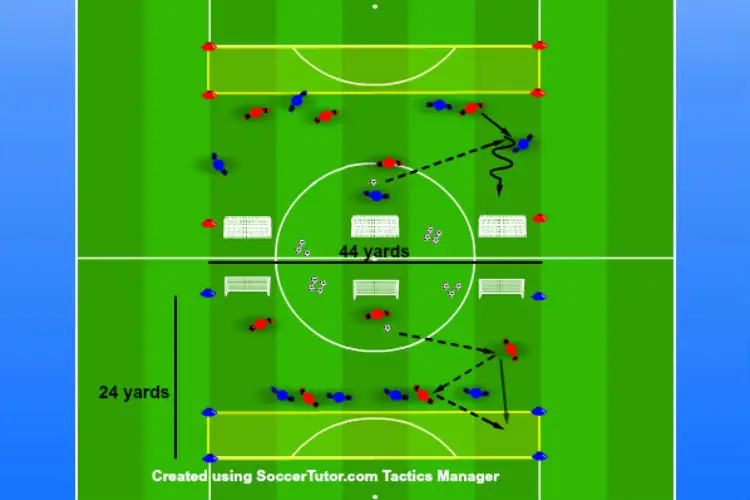
Instructions:
- The team of five will always start with a new ball from their end line and attempt to dribble in or pass to a teammate running into the end zone for a point. Players running into the box must remain onside.
- The defenders attempt to prevent the attackers from scoring, win the ball, and score in either of the attacker’s gates.
- The defenders must defend in a line and work on their positioning and ability to cover each other.
- If the ball goes out-of-bounds, or either team scores, a new ball is started with the attackers.
- Play four-minute games. The team with the most goals at the end of the game wins.
- Make coaching points and rotate players during the break. Play for 30 minutes.
Variations:
Touch-limit – Give players three, two or one-touch to increase the difficulty.
Easier for the defenders – Take off one attacker if the defenders are struggling to score 50% of the time.
More difficult for the defenders – Add one more attacker if the defenders are scoring more than 50% of the time.
Coaching Points:
- Let the players play a game before giving coaching points. See if the defending team can figure out how to defend together as a team.
- Teach the defenders to always have one player apply pressure to the ball, while the other three defenders shift and cover for the player that stepped out of line. Make the attackers try to play around the defenders!
- Encourage attackers to play quickly and move the ball forward when openings are created.
- Challenge the defenders to constantly move with the ball and stay compact!
3. 5v5 Round Robin
How the Drill Works:
Teams of five players, plus goalkeepers, compete against each other on a small field with full-size goals. Teams play fast-paced, four-minute games against every team and keep track of their wins, losses, and ties. Team with the best record at the end of the round robin tournament is declared champion.
Purpose:
Put players in a tight competitive space where goals can be scored easily if players are not completely engaged. Develop ability to attack and defend in a small space.
Setup:
- Set up one, 25x30-yard field.
- One full-size should be placed on each end line.
- Divide the players into teams of five players. If there are enough goalkeepers for each team, assign a goalkeeper to each team. If there are only two goalkeepers, position one goalkeeper in each goal.
- Two teams start on the field. The remaining teams rest and collect any stray soccer balls. Teams rotate after each round.
- All of the soccer balls should be placed around both goals.
- Play four-minute games. Each team should play each other at least twice.
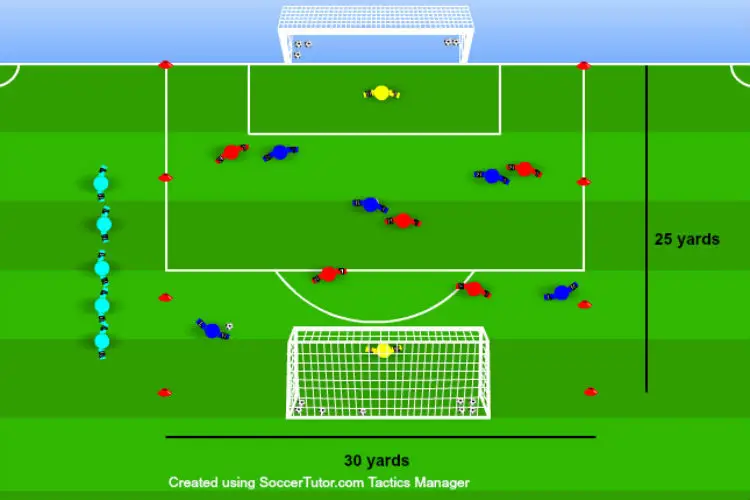
Instructions:
- Two teams compete against each other and attempt to score goals in their opponent’s goal.
- If the ball goes out-of-bounds for any reason, a new ball is started with the goalkeeper of the team that did not last touch it.
- If a goal is scored, the goalkeeper from the team that just scored starts a new ball.
- The team with the most goals at the end of the four-minute game wins. Ties are also possible.
- Rotate teams between rounds and reset the soccer balls.
- Three points for a win. One point for a tie. Zero points for a loss. Teams keep track of their points.
- Teams should play each other at least twice. Play more rounds if desired. Team with the most points at the end of the activity is the champion!
Variations:
Touch-limit – Give players three, two or one-touch to increase the difficulty.
Game time – Adjust the amount of time per game depending on the physical load the players need.
Coaching Points:
- Encourage the players to compete against each other! Try to create a competitive environment and push the players to give everything.
- Teach the players think quickly and constantly stay involved on the small field.
- Challenge the players to immediately close down their opponents and prevent shot attempts.
- Push the goalkeepers to be brave and get to every shot!
4. Crossing and Finishing Competition
How the Drill Works:
Two teams compete to score off of the most crosses. Teams alternate crosses while two players enter the penalty area and attempt to score in one-touch.
Purpose:
Develop crossing and finishing skills in a competitive team activity. Players increase their crossing accuracy while players in the box improve upon their finishing consistency.
Setup:
- Set up one, full-size goal.
- At least one goalkeeper is needed for this activity, but more goalkeepers would be best due to the high intensity. Extra goalkeepers should position themselves off to the side of the goal and rotate every three to five repetitions.
- Set up one cone on each side of the penalty box. Each cone should be five yards outside the penalty box and eight yards from the end line. Increase, or decrease, the cone distance and angle to the goal as needed.
- Setup two cones at the top of the penalty box. The cones should be 10 yards apart and should be five yards outside the penalty box.
- Divide the players into two, evenly numbered teams and assign each team to a jersey color.
- Have each team form a line behind one of top cones outside the box.
- Have each team send at least three players to the outside cone furthest away from them. These players will be the designated crossers for the round and should form a line behind their outside cone.
- Split the soccer balls evenly between the two crossing cones.
- Each crosser in line should have a ball at their feet.
- Complete at least three, five-minute rounds. Add more time and rounds as needed. Make coaching points between rounds.
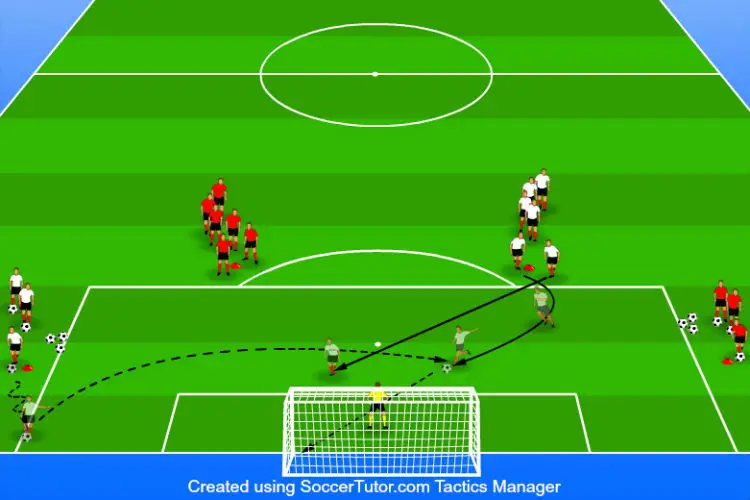
Instructions:
- The round starts with either crosser taking a touch towards the end line and then delivering a cross into the box.
- At the same time that the crosser takes their first touch, two players from the crosser’s team begin their runs in to the penalty area. One player runs to the front post, while the second player runs to the back post.
- The two players making runs into the box attempt to redirect the soccer ball and score.
- As soon as the first team finishes their turn, the second team can begin their turn from the opposite side.
- After each turn, the crosser goes to the back of their team’s crossing line while the shooters retrieve their shot and pass it, out of the way, towards the crossers.
- The two teams alternate crossing and finishing in this manner for the remainder of the round. The team with the most goals scored at the end of the round wins.
- Switch sides and rotate crossers after each round.
- Complete at least three, five-minute rounds. Add more time and rounds as needed.
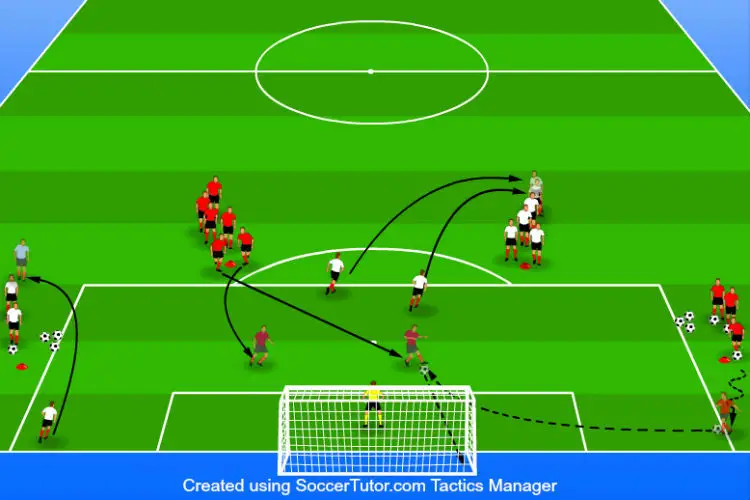
Variations:
Cross Variations – Switch up the crossing angles and distances. Crosses can also be on the floor or in the air depending on the focus of the activity.
Number of shooters – Depending on the number of players available, increase, or decrease, the number of players running into the box to finish. 1-3 shooters works best.
Coaching Points:
- Educate the players on their runs into the box. Players should time their runs precisely to arrive at their scoring position at the same time as the ball. The timing of the runs is the most important part to scoring consistently.
- Challenge the players crossing to deliver consistent services into the box. Crossers should try to pick out a player and serve it into their running path.
- Teach players that a powerful swing is not needed to score consistently. Players should be reminded, and taught, that they need to lock their ankle and redirect the ball with a small swing of the leg. The players’ forward running momentum will supply the power needed to put the ball in the back of the goal.
5. English Squares
How the Drill Works:
Two squares are set up with one team of five players in each square. The third team, in neither box, sends two of its players into one of the boxes and attempts to win the ball from the offensive team. If the offensive team completes six passes, they pass the ball to the other square for the game to continue. If the defensive team wins the ball, the team last lost it switches places with the defensive team.
Purpose:
Develop speed of play and decision-making. Players increase their vision and ability to play out of pressure.
Setup:
- Set up two 15x15 yard boxes with ten yards of space between them. Adjust the size of the boxes according to skill level and number of players.
- Divide the players into three teams. Five players are used in this example, but more players can be added. Adjust the box sizes accordingly if there are more players. Assign each team a different colored jersey.
- Assign one team to each box with the third being assign to the space between the two boxes.
- Gather all the soccer balls and place them outside the playing area for the coach to use as extra.
- Play four, four-minute games. Add more time and games as needed. Make coaching points between each round.
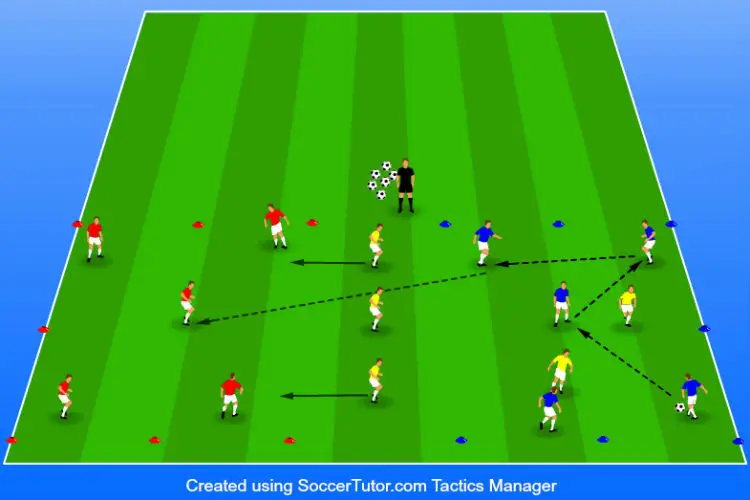
Instructions:
- To start the activity, the coach passes a ball to either team positioned inside a box.
- As soon as the team receiving the pass takes their first touch, two defenders from the team between the boxes, can enter the area and attempt to win the ball.
- The team in possession attempts to connect six consecutive passes before passing the ball across the middle to the opposite box.
- Teams are awarded one point each time they successfully complete their number of passes and pass the ball to the opposite box.
- Defenders prevent the offensive team from scoring by winning the ball and passing it across to the other box, or if the ball goes out-of-bounds for any reason. The offensive team is free to try and win the ball back until the ball goes out of their box.
- If the defensive team wins the ball, or the ball goes out-of-bounds, the team that lost the ball becomes the new defensive team and moves to the space between the two boxes. The team that successfully defended now positions themselves in the box the other team just left.
- A new ball is started from the coach and is passed to the team in the opposite box the ball was just in and the process continues.
- If the offensive team completes their six passes and plays the ball to the other box, the two defenders go back to the middle space, and two new defenders enter the opposite box.
- Defenders in the middle space can not block passes as they go across the middle space.
- Play four, four-minute games. Add more time and games as needed. See which team wins each game! Make coaching points between each game.
Variations:
Numbers – Divide in to three evenly numbered teams. Teams of seven, six, or four are all possible. Adjust the size of the boxes accordingly.
Number of defenders – Send more defenders into the offensive box if the teams are connecting too easily.
Middle space defenders – Allow the middle space defenders to block passes that come through the middle. This will make it more difficult to play across to the other box. Decide if players can play the ball over in the air or on the floor.
Touch limit – Limit the number of touches players get. Three-touch, two-touch, or one-touch depending on the quality of the players.
Point system – Change the number of consecutive passes needed for a point. Ten, eight, or five depending on the skill level of the players.
Space – Increase or decrease the size of the playing area to match the skill level of the group. Decrease the size to increase the speed of play. Increase the size to allow players more time on the ball.
Coaching Points:
- Remind the players to constantly move off of each other to create space and good angles of support to keep possession of the ball.
- Educate the players to be patient with ball. If the pass can not be easily completed to the other box after six passes, encourage the team to keep moving the ball until the pass can be made.
- Challenge the players to think quickly and to keep the ball moving so the defenders do not have a chance to steal it.
- Encourage the defenders to win the ball quickly and move as a group!
6. 3v3 - 1v1
How the Drill Works:
Teams of three compete on a mini-field. The field is divided into three even segments. One player from each team occupies their own segment and cannot leave it. The first team to score three goals wins.
Purpose:
This drill teaches positional discipline and forces individuals to take responsibility in their position.
Setup:
Create a 20 x 15-yard mini-field and place a mini-goal on each end.
Divide the field into three segments across the length of the field.
Split the team into groups of three.

Instructions:
Two teams compete at a time.
Each team has one defender, one midfielder, and one striker. Each of them occupies a segment of the field and must not leave that segment.
Essentially, there’s a 1v1 in each segment.
Choose one team to start in attack.
The game kicks off with the defender from the attacking team, who takes a goal kick from the end line.
The first pass is free, meaning the defenders may not intercept it.
After the first pass, a 3v3 game goes live.
Each payer must stay inside their assigned segment.
If a player leaves their zone, the other team is awarded a goal.
Players may pass the ball through the entire grid or shoot from a distance.
The first team to three goals wins.
Variations:
Tournament - Create a training tournament between all the teams.
Minimum pass rule - Players must make a certain number of passes before they can score.
Grid scoring - Only allow players to score in certain grids for a round. For example, the grids closest to the goal can only score.
Coaching points:
Players are allowed to score from any position. However, the main focus of this drill is positioning and build-up play. So, if players keep shooting from distance, change the rules to prevent this.
All players face 1v1 battles. In attack, each player must be able to move to get free and hold the ball up when they have it. When defending, players need to mark their opponent closely as they won’t get help from a teammate.
If you want your players to progress the ball upfield through neat passing, award two points for goals scored after three consecutive passes.
7. 3v3 + 1
How the Drill Works:
Two teams compete on a four-goal mini-field. Each team has one player on the opposition’s end line as the free playmaker. The playmaker can move along the line but cannot enter the pitch. Before either team can score, they must make at least two passes to their playmaker.
Purpose:
This drill helps improve players’ abilities to retain possession under pressure.
Setup:
Create a 20 x 15-yard mini-field with two mini-goals on either end.
Divide the team into groups of four.
Each team elects one member to act as the playmaker.
The playmaker stands between the opposition’s mini-goals along the end line. They can move along the end line but may not enter the field.

Instructions:
Two teams compete at a time.
The coach decides which team starts with the ball (use a coin toss or rock paper scissors if you like).
On the coach’s whistle, the game begins.
The teams compete in a first to three goals game.
Before a team can score, they must make at least two passes to their playmaker (end line player). The passes don’t have to be consecutive.
You can run a winner-stays-on style game or switch out the teams after every match.
Variations:
Touch limit - Introduce a two-touch limit, forcing players to pass the ball quickly
More passes to the playmaker - Increase the minimum number of passes to the playmaker before a team can score.
Tournament - If you have enough players, create a tournament.
Coaching points:
Encourage players to make give-and-go passes and build the play patiently, just as you’d like them to do in a game.
Since they have to pass the ball to the playmaker twice, each team must try to keep possession of the ball for some time before scoring. This will be hugely beneficial in games where your team is trying to break down a stubborn defense.
Players tend to get drawn toward the playmaker. However, this is counterproductive. Encourage both teams to use the entire width of the field to create space and good passing angles.
Further Reading: 123 Soccer Drills for All Ages and Skill Levels (With Images)

